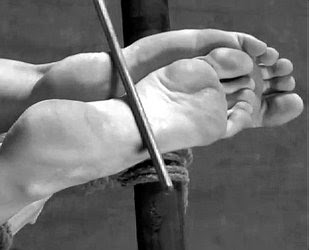The bastinado is a method of torture that over the centuries has spread to many areas of the world. It is often reported as a military punishment widespread in Ancient Rome, but this is due to an ambiguous translation that leads it to confuse it with the fustuarium, whose nature is very different.
The bastinado consists in beating the soles of the bare feet of the person subjected to the punishment with a whip, a rod or a stick. This form of foot whipping is known by various names, starting from the aforementioned bastinado (which derives from the Italian word "bastone", stick, as well as its German variant bastonade) to the Turkish falaka (which in other languages becomes falanga or falaqa), and the fact is none other than the application of a torture widespread throughout the world from very remote times with instruments of various kinds in a specific part of the body such as the soles of the feet.
The bastinado consists in beating the soles of the bare feet of the person subjected to the punishment with a whip, a rod or a stick. This form of foot whipping is known by various names, starting from the aforementioned bastinado (which derives from the Italian word "bastone", stick, as well as its German variant bastonade) to the Turkish falaka (which in other languages becomes falanga or falaqa), and the fact is none other than the application of a torture widespread throughout the world from very remote times with instruments of various kinds in a specific part of the body such as the soles of the feet.
 |
| Bastinado on female feet (credit: Julian Von Bredow/Wikicommons) |
The soles of the feet are a very sensitive part of the body, with a lot of nerve endings, and this corporal punishment mainly damages the skin and muscle tissue, making it often painful to walk and stand for those who are subjected to the punishment. Another characteristic of bastinado is that, if not applied in a particularly aggressive way, it rarely leaves visible marks. A particularly harsh application of torture, through particularly hard tools such as metal rods, is capable of leaving permanent damage to the musculoskeletal system, but generally it was used in milder forms, as we shall see. In addition to this, in many cases a mental factor was added to this corporal punishment, due to the fact that those who suffer it are forced to stand barefoot, a fact in many cases considered humiliating or degrading, as it was typical of slaves and inmates.
The origins of this corporal punishment are very ancient: some of its possible testimonies can be found in the Bible (specifically in the books of Proverbs, Leviticus and Deuteronomy), which suggest that this practice has very distant origins in time.
The origins of this corporal punishment are very ancient: some of its possible testimonies can be found in the Bible (specifically in the books of Proverbs, Leviticus and Deuteronomy), which suggest that this practice has very distant origins in time.
Some testimonies also speak of this punishment used in Ancient Egypt, while erroneous evidence of its use in Ancient Rome is found. As previously said, in fact, a translation from the Greek text of the Stories of Polybius indicates as "bastinado" the very different punishment of the fustuarium, referring to the use of "bastone" (Italian word for "stick") to practice torture. The fustuarium, in fact, consisted in the beating (often to death) of the condemned by several people on all parts of the body, and was applied in a particular way in the army.
 |
| Bastinado in Ancient Egypt |
In Ancient Rome, however, domestic corporal punishments on slaves were very common given with whips and sticks, often similar to rods, and especially considering the fact that slaves were often barefoot we must imagine how plausible that bastinado was imparted on them as punishment for various reasons, even in the absence of specific testimonies.
In the following centuries, the torture of the bastinado spread mainly in the Far East and in the Middle East, where it was particularly used, especially as a disciplinary punitive practice. Usually the victim was made to lie down on the ground and his feet were tied to a horizontal stick placed at a higher height.
In the following centuries, the torture of the bastinado spread mainly in the Far East and in the Middle East, where it was particularly used, especially as a disciplinary punitive practice. Usually the victim was made to lie down on the ground and his feet were tied to a horizontal stick placed at a higher height.
The contacts (also of a war nature) that between the Middle Ages and the following centuries involved the Arab world and Europe led to a greater knowledge and diffusion of this corporal punishment, and also for this reason it is mentioned in the Ratto dal Serraglio and in the Magic Flute by Wolfgang Amadeus Mozart.
In more recent times, the bastinado has been used in some violent repression as a form of corporal punishment in many countries of the world, and even today, unfortunately, in countries where there is no respect for human rights it is a widespread corporal punishment.
Parallel to this, as for many other tortures of the past, it is used (obviously in a healthy, safe and consensual way) as an erotic BDSM practice.
In more recent times, the bastinado has been used in some violent repression as a form of corporal punishment in many countries of the world, and even today, unfortunately, in countries where there is no respect for human rights it is a widespread corporal punishment.
Parallel to this, as for many other tortures of the past, it is used (obviously in a healthy, safe and consensual way) as an erotic BDSM practice.


Nessun commento:
Posta un commento
Info sulla Privacy